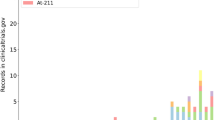Abstract
Radiation doses to the tumour and non-tumorous liver compartments from yttrium-90 microspheres in the treatment of hepatic cancer, as estimated by a partition model, have been verified by correlation with the actual doses measured with a beta probe at open surgery. The validity of the doses to the lungs, the tumour and non-tumorous liver compartment as estimated by the partition model was further evaluated in clinical settings. On the basis of the observation that one of three patients who received more than 30 Gy from a single treatment and one of two patients who received more than 50 Gy from multiple treatments developed radiation pneumonitis, it was deduced that an estimated lung dose <30 Gy from a single treatment and a cumulative lung dose <50 Gy from multiple treatments were probably the tolerance limits of the lungs. Three of five patients who received lung doses >30 Gy as estimated by the partition model and were predicted to develop radiation pneumonitis, did so despite the use of partial hepatic embolization to reduce the degree of lung shunting. Furthermore, a higher radiological response rate and prolonged survival were found in the group of patients who received higher tumour doses, as estimated by the partition model, than in the group with lower estimated tumour doses. Thus the radiation doses estimated by the partition model can be used to predict (a) complication rate, (b) response rate and (c) duration of survival in the same manner as the actual radiation doses measured with a beta probe at open surgery. The partition model has made selective internal radiation therapy using90Y microspheres safe and repeatable without laparotomy.
Similar content being viewed by others
References
Ohto M, Ebara M, Yoshikawa M, et al. Radiation therapy and percutaneous ethanol injection for the treatment of hepatocellular carcinoma. In: Okuda K, Ishak KG, eds.Neoplasms of the liver. Tokyo Berlin Heidelberg New York: Springer; 1987: 335–341.
Sherman DM, Weichsebaum R, Order SE, Cloud L, Trey C, Piro AJ. Palliation of hepatic metastases. Cancer 1978; 41: 2013–2017.
Yoo HS, Park CH, Suh JH, et al. Radioiodinated fatty acid esters in the management of hepatocellular carcinoma: preliminary findings.Cancer Chemother Pharmacol 1989; 23 Suppl: S54-S58.
Philips R, Karnofsky DA, Hamilton LD, Nickson JJ. Roentgen therapy of hepatic metastases.Am J Radiol 1954; 71: 826–834.
Ingold JA, Reed GB, Kaplan HS, Bagshaw MA. Radiation hepatitis.Am J Roentgenol Radium Ther Nucl Med 1965; 93: 200–208.
Ariel M. Treatment of inoperable pancreatic and liver cancer by the intraarterial administration of radioactive isotopes (Y90 radiating microspheres).Ann Surg 1965; 162: 267–278.
Ariel IM, Pack GT. Treatment of inoperable cancer by intraarterial radioactive isotope and chemotherapy.Cancer 1967; 20: 793–804.
Ariel IM, Padular C. Treatment of asymptomatic cancer to the liver from primary colon and rectal cancer by intraarterial administration of chemotherapy and radioactive isotopes.J Surg Oncol 1982; 209: 151–156.
Mantravardi RVP, Spigos DG, Tan WS, Felix EL. Intraarterial yttrium-90 in the treatment of hepatic malignancy.Radiology 1982; 142: 783–786.
Blanchard RJW. Treatment of liver tumours with yttrium-90 microspheres.Can J Surg 1982; 26: 442–443.
Herba MJ, Illescas FF, Thirlwell MP, et al. Hepatic malignancies: improved treatment with intraarterial yttrium-90 microspheres.Radiology 1988; 169: 311–314.
Blanchard KJ, Morrow IM, Sutherland JB. Treatment of liver tumours with yttrium-90 microspheres alone.Can Assoc Radiol J 1989; 40: 206–210.
Houle S, Yip T, Shepherd F, et al. Hepatocellular carcinoma: pilot trial of treatment with yttrium-90 microspheres.Radiology 1989; 172: 857–860.
Shepherd FA, Rostein LE, Houle S, Yip TCK, Paul K, Sniderman KW. A phase I dose escalation trial of yttrium-90 microspheres in the treatment of primary hepatocellular carcinoma.Cancer 1992; 70: 2250–2254.
Yan ZP, Lin G, Zhao H-Y, Dong Y-H. An experimental study and clinical pilot trials of yttrium-90 microspheres through the hepatic artery for treatment of primary liver cancer.Cancer 1993; 72: 3210–3215.
Gray BN, Anderson JE, Burton MA, et al. Regression of liver metastases following treatment with yttrium-90 microspheres.Aust NZJ Surg 1992; 62: 105–110.
Lau WY, Leung TWT, Ho S, et al. Treatment of inoperable hepatocellular carcinoma with yttrium-90 microspheres. A phase I and II study.Br J Cancer 1994; 70: 994–999.
Ho S, Lau WY, Leung WT, et al. Partition model for estimating radiation doses from yttrium-90 microspheres in treating hepatic tumours.Eur J Nucl Med 1996; 23: 947–952.
Leung WT, Lau WY, Ho SKW, et al. Measurement of lung shunting in hepatocellular carcinoma with intrahepatic-arterial technetium-99m macroaggregated albumin.J Nucl Med 1994; 35: 70–73.
Lau WY, Leung TWT, Ho S, et al. Diagnostic pharmacoscintigraphy with technetium-99m macroaggregated albumin in the prediction of tumour to normal uptake ratio during therapy of inoperable hepatocellular carcinoma with yttrium-90 microspheres.Br J Radiol 1994; 67: 136–139.
Synder WS, Ford MR, Warner GG, Watson SB. “S” Absorbed dose per unit accumulated activity for selected radionuclides and organs.NM/MIRD Pamphlet No. 11. New York: Society of Nuclear Medicine; 1975.
Leung WT, Lau WY, Ho SKW, et al. Radiation pneumonitis after selective internal radiation treatment with intraarterial90yttrium-microspheres for inoperable hepatic tumours.Int J Radiat Biol Phys 1995; 33: 919–924.
Lin M. Radiation pneumonitis caused by yttrium-90 microspheres: radiologic findings.Am J Roentgenol 1994; 162: 1300–1302.
Margolis LW, Philips TL. Whole lung irradiation for metastatic tumour.Radiology 1969; 93: 1173–1178.
Fox RA, Klemp PFB, Egan G, Nina LL, Burton MA, Gray BN. Dose distribution following selective internal radiation therapy.Int J Radiat Oncol Biol Phys 1991; 21: 463–467.
Bate D, Guttman RJ. Changes in lung and pleural following two-million-volt therapy for carcinoma of the breast.Radiology 1957; 73: 372–383.
Fulkerson WJ, Mclendon RE, Prosuitz LR. Adult respiratory distress syndrome after limited thoracic radiotherapy.Cancer 1986; 57: 1941–1946.
Author information
Authors and Affiliations
Rights and permissions
About this article
Cite this article
Ho, S., Lau, W.Y., Leung, T.W.T. et al. Clinical evaluation of the partition model for estimating radiation doses from yttrium-90 microspheres in the treatment of hepatic cancer. Eur J Nucl Med 24, 293–298 (1997). https://doi.org/10.1007/BF01728766
Received:
Revised:
Issue Date:
DOI: https://doi.org/10.1007/BF01728766




